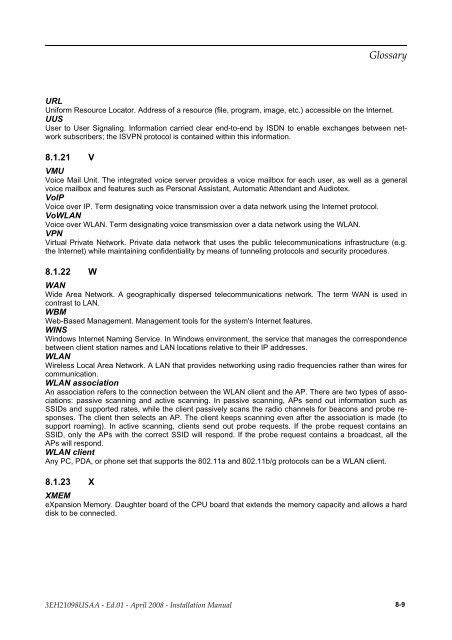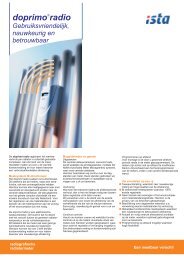Installation Manual
Installation Manual
Installation Manual
You also want an ePaper? Increase the reach of your titles
YUMPU automatically turns print PDFs into web optimized ePapers that Google loves.
URL<br />
Uniform Resource Locator. Address of a resource (file, program, image, etc.) accessible on the Internet.<br />
UUS<br />
User to User Signaling. Information carried clear end-to-end by ISDN to enable exchanges between network<br />
subscribers; the ISVPN protocol is contained within this information.<br />
8.1.21 V<br />
VMU<br />
Voice Mail Unit. The integrated voice server provides a voice mailbox for each user, as well as a general<br />
voice mailbox and features such as Personal Assistant, Automatic Attendant and Audiotex.<br />
VoIP<br />
Voice over IP. Term designating voice transmission over a data network using the Internet protocol.<br />
VoWLAN<br />
Voice over WLAN. Term designating voice transmission over a data network using the WLAN.<br />
VPN<br />
Virtual Private Network. Private data network that uses the public telecommunications infrastructure (e.g.<br />
the Internet) while maintaining confidentiality by means of tunneling protocols and security procedures.<br />
8.1.22 W<br />
WAN<br />
Wide Area Network. A geographically dispersed telecommunications network. The term WAN is used in<br />
contrast to LAN.<br />
WBM<br />
Web-Based Management. Management tools for the system's Internet features.<br />
WINS<br />
Windows Internet Naming Service. In Windows environment, the service that manages the correspondence<br />
between client station names and LAN locations relative to their IP addresses.<br />
WLAN<br />
Wireless Local Area Network. A LAN that provides networking using radio frequencies rather than wires for<br />
communication.<br />
WLAN association<br />
An association refers to the connection between the WLAN client and the AP. There are two types of associations:<br />
passive scanning and active scanning. In passive scanning, APs send out information such as<br />
SSIDs and supported rates, while the client passively scans the radio channels for beacons and probe responses.<br />
The client then selects an AP. The client keeps scanning even after the association is made (to<br />
support roaming). In active scanning, clients send out probe requests. If the probe request contains an<br />
SSID, only the APs with the correct SSID will respond. If the probe request contains a broadcast, all the<br />
APs will respond.<br />
WLAN client<br />
Any PC, PDA, or phone set that supports the 802.11a and 802.11b/g protocols can be a WLAN client.<br />
8.1.23 X<br />
��������<br />
XMEM<br />
eXpansion Memory. Daughter board of the CPU board that extends the memory capacity and allows a hard<br />
disk to be connected.<br />
������������ � ����� � ����� ���� � ������������ ������ 8-9





